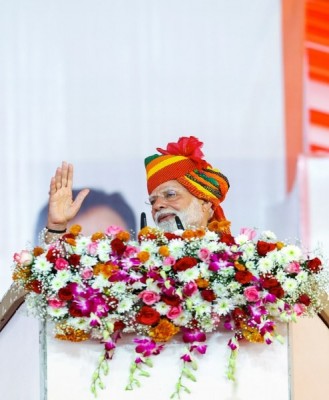
Congress manifesto for Lok Sabha election 2019 raises more questions than hope
With less than a week left for the elections, the largest opposition party Congress finally released its much awaited manifesto for the 2019 Lok Sabha Elections describing it as the ‘voice of the people’ which seeks to sharply differentiate the grand-old-part party from the BJP by promising to scrap the sedition law, dilute AFSPA and withdraw the citizenship amendment bill, alongside offering populist pledges on minimum income support for all poor families, improved healthcare, jobs and education.
"The main issues in the country today are unemployment and farmer distress," said Gandhi, releasing the manifesto. "The economy is jammed, and everyone agrees that India's economy is stuck, so that needs to be restarted."
The 55-page document titled ‘Hum Nibhayenge’ (We will deliver) has been divided into Kaam (Employment), Daam (Economy), Shaan (Pride), Sushashan (Governance), Swabhimaan (Self-rights), Samman (Dignity).
A look at our new 2019 Manifesto website launched by Rajya Sabha MP & Chairman of Manifesto Committee Shri @PChidambaram_IN along with Rajya Sabha MP & Convenor of Manifesto Committee Shri @rajeevgowda. Send us your ideas on: https://t.co/jjOt3XJy0t#JanAawaaz pic.twitter.com/Ejf2ENx99p
— Congress (@INCIndia) October 30, 2018
The minimum income NYAY scheme, employment, a promise to abolish NEET and abolishing the defamation and sedition laws form other parts of the Congress’s manifesto.
The manifesto was released by party president Rahul Gandhi on a dedicated website with top party leaders, including former Prime Minister Manmohan Singh, UPA chairperson Sonia Gandhi and former Finance minister P Chidambaram in attendance at the party’s Akbar Road headquarters in New Delhi, but in an unexpected development, the website itself crashed after the document was uploaded.
Diluting AFSPA in Kashmir
One of the statements in the manifesto states that the party will significantly curb the powers of Army in Kashmir if it is voted to power, by diluting the Armed Forces Special Powers Act (AFSPA). The need for including this is since Congress is clutching to the proverbial last straws in its bid to seek votes and remain relevant in national politics. The voters in Kashmir valley and anti-Modi lobby across the nation are the obvious targets.
The proposal has faced intense controversy at a time when security forces are fighting an intensifying cross-border insurgency backed by Pakistan.
Describing the Congress’s manifesto as ‘dhakolsa patra’ (document of falsehood), Prime Minister Narendra Modi said at a meeting in Bengal that by promising to review the AFSPA that shielded security forces from terrorists, the Congress has damaged the “morale” of the security forces, made them “helpless” in the fight against terror. He also accused the Congress of “bowing to terrorism for vote bank politics.”
‘NYAY’ (Minimum Income Guarantee) scheme
The manifesto reiterates Rahul Gandhi’s promise of a ‘Minimum Income Guarantee’ of Rs.72,000 per annum for 20% of the poorest in India under the ‘NYAY’ scheme. Already, the same promise has seen criticism from various quarters on the grounds of being poorly thought out and unworkable.
Former Niti Aayog vice-chairman Arvind Panagariya has said the implementation of the ambitious 'Nyay' scheme not only poses a "fiscal challenge" to India's economy but also has a "serious incentive problem".
Scrapping Niti Aayog
The manifesto also promises to dismantle the Niti Aayog and replace it with a ‘leaner’ Planning Commission which may irk those reminded of the days of heavy government interventionism in the economy in India’s socialist era.
The Planning Commission which was set up in 1950 by the Congress government, inspired by the erstwhile Soviet styled planned economy, was replaced by the more inclusive Niti Aayog by the Modi dispensation.
VK Saraswat, member of NITI Aayog said in response that it is a great institution and it is normal that such statements are made during elections.
GST 2.0
Congress’s manifesto promises to review and replace the current GST system with GST version 2.0. The manifesto states that “the GST 2.0 regime will be based on a single, moderate, standard rate of tax on all goods and services."
"The rate will be revenue neutral to the current indirect tax revenues of the Central and State Governments and will take note of the potential of GST 2.0 to boost their tax revenues.”
Jobs
The Congress has pledged to make employment its main priority, both in the public and private sector. It aims to fill all 4 lakh central government vacancies before March 2020 and would persuade state governments to fill their 20 lakh vacancies.
It also plans to create around 10 lakh new ‘Seva Mitra’ positions in every gram panchayat and urban local body across the country. The manifesto says businesses will be rewarded for job creation and employing more women and firms with over 100 employees will have to implement an apprenticeship programme.
Finance Minister Arun Jaitley has criticised the Congress manifesto, saying that the Opposition party’s promises are ‘dangerous and unimplementable’ and the agenda seems to be the ‘balkanisation of India’.
“When out of ignorance, he makes unimplementable and dangerous promises, I am sure the nation would not be in a mood to oblige him, for implementing the kind of promises which are contained in this manifesto”, said Jaitley.
But then, this is only half the battle. The Congress manifesto completely ignores reforming the present system of selecting judges, an opaque, nepotistic nomination process where cliques and mutual back-scratching thrive, where the elected representatives of the people have no role.
Support Our Journalism
We cannot do without you.. your contribution supports unbiased journalism
IBNS is not driven by any ism- not wokeism, not racism, not skewed secularism, not hyper right-wing or left liberal ideals, nor by any hardline religious beliefs or hyper nationalism. We want to serve you good old objective news, as they are. We do not judge or preach. We let people decide for themselves. We only try to present factual and well-sourced news.







